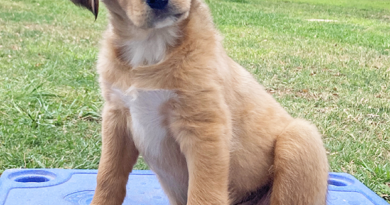Guide to How to Train a Pit bull and Why It Is So Important – Dogster
Raising a pit bull so he’s friendly and confident involves committing to socialization. Training your pit bull not to bite and to be well socialized around other dogs is non-negotiable. And because pit bulls have a stigma, being a responsible pet parent is part of the pittie package.
What’s a pit bull?
Pit bull isn’t a breed, but rather a collection of breeds, who descended from crossing terriers with bulldogs. Pit bulls and several other dogs with similar histories and appearances are also categorized as bully breeds, but pit bulls are commonly considered to be:
- American Pit Bull Terrier (APBT)
- American Staffordshire Terrier
- Staffordshire Bull Terrier
- American Bulldog (American Bully)
Raising and socializing a pit bull puppy
The importance of socialization for all puppies can’t be overstated, but it’s especially true for pit bulls. Socialization is the process of systematically and positively introducing puppies to literally everything in our human-centric world, especially people and other animals.
This is particularly critical during the sensitive (or primary) socialization period between 3 to 14 weeks old, where a puppy’s brain is most like a sponge. Dog breeders and dog rescues care for puppies during much of this time, so select one that has a dynamic socialization program, since you’ll pick up where they leave off.
Within the sensitive period is the first fear period, between 8 to 12 weeks, when puppies can develop lasting negative associations and fear, especially toward people and other dogs. So, if an activity or situation/environment starts to go south:
- Stay calm and keep good mojo flowing
- Remove the offensive stimulus (or the puppy) from the situation
- Turn the situation into a happy time: give treats, belly rubs, etc.
- Follow up immediately with a quick fetch of the ball, tug of the toy or other fun activity
- Don’t punish the fear of a “new thing” — help relieve it!
While genetics play a big role in behavior, so do environment and learning history. All pit bulls are not born dog aggressive, but the potential exists for dog-dog aggression more so than in other breeds. So, set up your pup’s environment for success and only use rewards-based methods to create a foundation for life-long learning.
Socialization continues into adolescence, although the landscape looks a bit different. In short, from roughly 6 to 12 plus months of age, puppies go through “puberty,” test boundaries and begin to display breed-specific traits. Adolescents may also go through a second fear period which lasts about 2 to 3 weeks but, unlike the primary period, you can’t nail down the timeline. You’ll know if he’s in this phase because he’ll start to act wary or fearful of things he was cool with before. Tread lightly here: even one such incident during this period can have permanent emotional effects and behavioral consequences, so make sure he floats through without any painful or scary experiences.
How to train a pit bull puppy not to bite
Don’t gloss over puppy biting or mouthing: train your pit bull puppy not to bite. Follow these four simple rules:
- DON’T ever roughhouse with him!
- Discourage any teeth on people, and never reward even playful biting.
- Even if it’s accidental, if any tooth touches any part of a person it’s game over, period.
- Mouthy pit? Give a toy instead, and ensure appropriate chew toys are always available.
To learn how to stop puppies from mouthing and nipping, check out former Dogster columnist Victoria Stilwell’s steps on how to stop this behavior.
Why an under/unsocialized and untrained pit bull can be a serious problem
Dogs who are fearful usually were not adequately or positively socialized during formative periods. Fear can lead to extreme shyness or even over reactivity and aggression. And that’s a big problem, especially for pits and possibly for you.
Pit bulls have long been branded an aggressive breed. After a 1987 Time magazine cover story portrayed them as dangerous, mainstream media latched into it. Soon afterward Breed Specific Legislation (BSL) was born and has dotted the national landscape since.
Therefore, people fear and even loathe pit bulls or any dogs who have the misfortune of looking like one. They’re often the first euthanized in shelters, even ahead of older or sickly dogs since many shelters can’t adopt them out due to local laws or pit bulls’ regrettable reputations. The good news is since 2018 nearly 70 repeals of BSL have been confirmed.
The CDC recommends against BSL and stopped tracking breeds involved in fatal dog attacks in 1998. However, anti-pit bull groups still sensationalize pit bull bite stories and tend to disproportionately attribute dog attacks to pit bulls. Pit bulls and other large dogs do cause more severe damage than do small dogs; however, bites from small dogs typically don’t require hospital visits and therefore are usually underreported. Remember: be sure part of your training and socialization includes a no-teeth-on-people approach. A biting pit bull is a huge liability to himself and you: consequences can range from quarantine to euthanasia to you landing in court.
And finding a rental for you and your pittie can be tough. However, property owners are increasingly receptive if your dog is well trained and has Canine Good Citizen certification through the AKC, which can also help you get renter’s or homeowner’s insurance. Companies who offer access to insurance policies for people with pits include:
- All State
- Farmers
- State Farm
- Nationwide
- USAA (for military families)
- Chubb
You also might consider getting dog bite insurance to protect yourself and your dog, especially if your pit is fearful, over reactive, aggressive or has a bite history. And keep your dog licensed and current on vaccinations.
Pit bull training tips
Pit bulls are highly intelligent, very trainable and require solid training and impulse control. Start by teaching your dog solid Leave it and Take it and Drop it cues.
Tug of war is the perfect game to teach impulse control because it reinforces these cues as well as sets up clear boundaries for play. (https://www.youtube.com/watch?v=x9mPoWuvnLg)
Other skills all pit bulls should know:
An over-aroused dog can cause problems, so get on board with a good relaxation protocol to help your pit bull learn calm behavior for when things get jazzed up.
Finally, stay on top of any behavioral issues so things don’t get sticky and remember: having a pit bull means understanding the scrutiny your dog will be under most of the time.
Be mindful of these pit bull traits

Pit bulls were originally bred for bull and bear baiting, so a prized trait was gameness meaning to persevere regardless of threat or injury. Gameness and aggression aren’t the same: a passive winner was better than an aggressive loser. Unfortunately, this eagerness became a prized trait for dog fighters who continue to feed the stereotypes of pit bulls as vicious killers. Today’s mainstream pit bulls may possess this singlemindedness to some degree, but mainly to hang out with you: they were also bred to have deep attachments to humans.
At the end of the day, many pits are terriers. APBT’s are especially known to have high prey drive. In addition to impulse control exercises, provide an outlet for the first few parts of the prey drive sequence (eye/orient, stalk, chase) as a healthy way to let them get in touch with their instincts and provide enrichment. Try a flirt pole or even a spring pole.
Pit bulls are smart and can be high energy and high drive. A bored pittie can quickly develop behavior problems, so create a plan for both mentally and physically stimulating your dog so he has positive outlets for his energy.
Fun sports to try:
- fly ball
- parkour and other obstacle-related activities
- dock jumping
- weight pulling
- GRC (Gameness, Relationship, Control)
- cani-cross
- barn hunts or earth dog trials
Pits can even do well at agility and flying discs. Wallace the pit bull defied all odds and became a world champion disc dog winning dozens of titles.
Pit bulls aren’t for everyone and not for a first-time dog parent. Although they often get a bad rap, pits are loyal, fun-loving and wicked smart. Raising and training your pit bull to be well-socialized to other dogs and people and well-mannered goes with the territory: these breeds come with extra responsibility. Pit bulls deserve for us to be champions for them so they can be ambassadors for their breeds and themselves.




